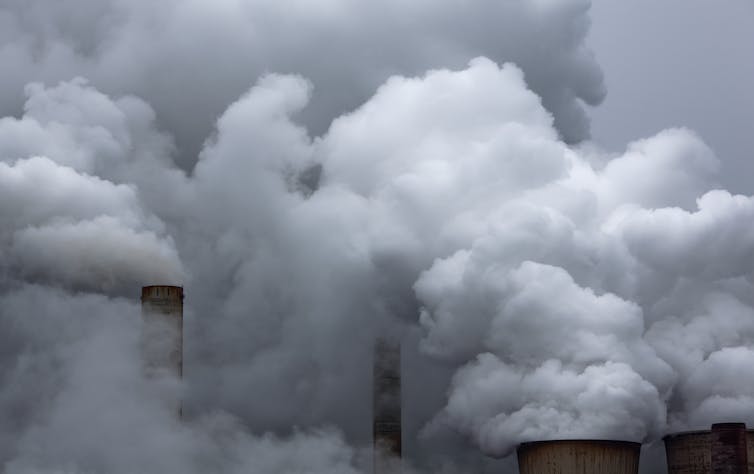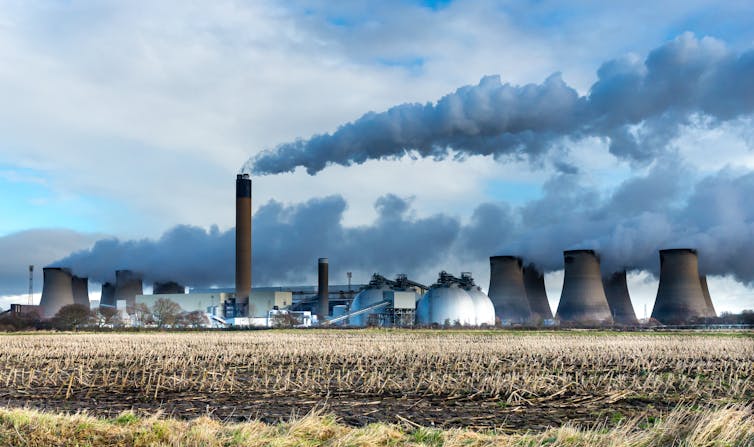Immediate phase out of fossil fuels could keep warming below 1.5C

Chris Smith, University of Leeds
Despite some positive climate action, new fossil fuel infrastructure is still being built and deployed. Dozens of new coal power plants are currently planned or under construction, for instance, while petrol car sales will nearly hit 100m in 2019.
But what if all that ceased tomorrow? It turns out that if we built no more fossil fuel infrastructure and instead replaced existing infrastructure at the end of its productive life with a zero carbon alternative we could limit peak temperature rise to 1.5°C – as long as we start now.
Colleagues and I recently analysed what would happen to global emissions if fossil fuel power plants, cars, ships, aircraft and industrial infrastructure were all phased out. Our results are published in Nature Communications. This may be a hypothetical scenario, given a full phase out is unlikely to happen any time soon, but calculating what would happen in such a scenario gives us a better idea of the challenge ahead.
In our optimistic scenario, the process of replacing all the fossil fuel infrastructure with zero carbon alternatives (or not replacing it at all) began from the end of 2018. Doing this we found that the chance of keeping global temperature rise to below 1.5°C was 64%.
Delaying a fossil phase out until 2030 would make this a lot less likely, even if the phase out rate was sped up.
Four decades of committed warming
A coal power plant is typically operated and emits carbon dioxide (CO₂) for about 40 years. So, every new coal plant built in the recent past or today carries a climate change commitment. For instance, Drax, the UK’s largest power plant, used to burn coal exclusively and has probably warmed the planet by a few ten-thousandths of a degree over its lifetime. That isn’t much by itself, but such warming all adds up. We call this the “committed warming” from fossil fuel infrastructure. Drax now predominately burns wood pellets, and is one example of how fossil fuel infrastructure could be replaced.

Coatesy / shutterstock
Our analysis produces a scenario that reduces CO₂ emissions to nearly zero over 40 years. This compares with the recent IPCC special report on 1.5°C, which concluded that reducing emissions to net zero over 35 years was required to get even a 50% chance of limiting global warming to 1.5°C.
The additional, narrow window of five years to get to net zero can be explained by different approaches. Some of this difference is accounted for by the timing of emissions phase out. As every year of procrastination brings the date by which we’ll have to reach net zero emissions forward by two years, even delaying until after 2020 rather than 2018 means that a 40 year phase out would have to happen in 36 years to achieve the same outcome. We also used historical temperature observations to guide the future climate response to emissions. Our projection of additional warming for each additional tonne of CO₂ is a little lower than the IPCC’s best estimate, although well within the “likely” range.
Alongside power stations, cars, ships and planes, we also applied the “asset lifetime” assumption to meat cattle. Cows produce a lot of methane, so if we ate them all over the next three years without breeding any more, we could certainly reduce our greenhouse gas emissions considerably while having a gluttonous time doing so. Non-livestock emissions are more tricky and harder to mitigate – we still need to eat, and grow crops using fertilisers – but we assumed that we get more savvy at doing so, eventually reaching zero emissions by 2100.

Cameron Watson/Shutterstock
Limits to the study
Our study also comes with a number of important caveats. For instance, we did not delve into whether coal power will be replaced with solar panels or wind turbines, and we weren’t concerned with the exact sort of electric vehicle that will replace the petrol car. What matters to us is that these replacements are zero carbon, or that fossil fuel infrastructure is not replaced at all.
In many cases, zero carbon alternatives do not exist or might be difficult to scale up (for example in aviation). We also assumed that expected lifetime of fossil fuel infrastructure would not increase and that the surviving infrastructure would not be used more intensively (no rebound effects). Lifecycle effects are not included either: with our current high-carbon industry, manufacturing a wind turbine costs energy and creates emissions, even if the energy produced from it does not.
In the fossil phase out scenario, we project temperatures would peak at anywhere between 0.1℃ and 0.8℃ above today – this shows the level of uncertainty in how the climate will respond, mostly related to how much warming is masked by air pollution in the present day. Because air pollution reflects sunlight and can brighten clouds, it reduces some of the warming we would otherwise experience. If fossil fuels are phased out, this air pollution will be removed, unmasking the warming. Importantly however, the CO₂ and fossil methane emissions would also reduce at the same time, meaning there would not be a sudden spike in warming from phasing out fossil fuels.
The good news is that the optimistic scenario we looked at in our research found that current global fossil fuel infrastructure is not yet at the point where it will definitely take us over 1.5°C. However, as every year’s delay makes staying below 1.5°C less and less likely, urgent action is still needed.
Indeed, building more of this infrastructure carries an economic cost. If more fossil fuels plants “lock in” more warming, then remedial action would involve premature retirement of these “stranded assets”, or costly negative emissions technologies to take carbon out of the air. We must do our best to avoid fossil fuel lock in and bring forward alternative technologies as quickly as possible.![]()
Chris Smith, Research Fellow in Physical Climate Change, University of Leeds
This article is republished from The Conversation under a Creative Commons license. Read the original article.
